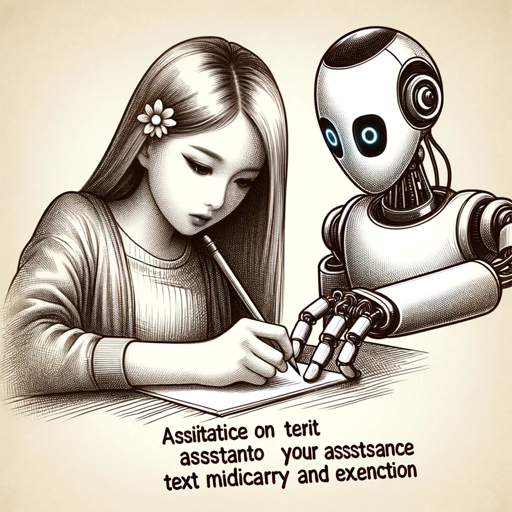Stately GPT-AI-driven system design support
AI-powered expert for state machines and workflows
Explain state machines
Define actor model
Create a workflow
Event-driven programming?
Related Tools
Load More
Correct English GPT
Write English like a native speaker. Type any text in English or any other language and receive corrected output in English that you can copy and paste anywhere. To improve the style of the corrected text, send "s"

GPT Builder Builder
Your guide to creative GPT building.

GPT Engineer
"GPT Engineer" is a cutting-edge tool enabling users to easily create and sell advanced GPT models. Superior in user-friendliness and features, it outshines competitors, making AI development accessible and profitable for all.

GPT Action Creator
This GPT helps create Action Schemas which other GPTs can use.
Bullet Point GPT

Concise GPT
Provides direct, concise answers without warnings, clarifying when uncertain.
20.0 / 5 (200 votes)
Introduction to Stately GPT
Stately GPT is a specialized AI assistant tailored for handling questions related to state machines, statecharts, the actor model, and event-driven architectures. Designed to assist developers, architects, and engineers, its purpose is to simplify and explain complex concepts around these programming paradigms. It is adept at explaining theoretical concepts, generating practical examples, and guiding users through the design and implementation of these models in software systems. A core feature of Stately GPT is its ability to provide interactive, step-by-step explanations, making it an ideal companion for technical discussions and troubleshooting. For instance, imagine a scenario where a developer is trying to build a multi-step workflow using a statechart for a robotic system. Stately GPT can break down each step, explain how to represent it as a state, define transitions, and demonstrate how the system can handle unexpected events or interruptions in the process. This detailed guidance, focusing on both theory and practical application, is key to Stately GPT's function.

Key Functions of Stately GPT
Explaining State Machines and Statecharts
Example
A developer building a complex user interface using finite state machines in a JavaScript framework like React.
Scenario
The developer consults Stately GPT to understand how to represent different UI states (loading, success, error) in a state machine. Stately GPT provides a breakdown of how to structure the machine, including transitions between states and event handlers for user inputs. The developer gains clarity on edge cases and how to represent conditional logic effectively in a statechart.
Designing Event-Driven Architectures
Example
A software architect tasked with designing an event-driven microservices architecture.
Scenario
The architect seeks guidance on how to model a system where different services communicate asynchronously via events. Stately GPT explains how to structure event buses, define event producers and consumers, and manage event queues. The architect uses these insights to implement an event-driven system that scales efficiently while handling complex business workflows.
Actor Model Patterns
Example
A developer creating a distributed system using the actor model in a framework like Akka.
Scenario
The developer needs to manage concurrency and fault tolerance in a system handling thousands of concurrent messages. Stately GPT walks the developer through designing actors to process messages, manage state, and handle errors through message supervision. This results in a robust distributed system that can scale horizontally while maintaining fault isolation.
Ideal Users of Stately GPT
Software Developers and Engineers
Developers who need to implement state machines, event-driven architectures, or actor model patterns will find Stately GPT invaluable. These users benefit from its ability to explain complex concepts with real-world examples and provide solutions to common challenges faced in software design.
Software Architects and System Designers
Architects responsible for designing scalable, resilient systems can leverage Stately GPT to explore patterns such as microservices, message-passing systems, and distributed systems. Stately GPT assists them in creating high-level designs, breaking down components, and optimizing system workflows through event-driven and state-based paradigms.

How to Use Stately GPT
1
Visit aichatonline.org for a free trial without login, no need for ChatGPT Plus.
2
Familiarize yourself with Stately GPT's interface, specifically designed for state machines, XState, and event-driven architecture inquiries.
3
Start by asking specific questions related to state machines, actor models, or event-driven systems to get detailed, expert-level responses.
4
Explore other use cases like debugging event-driven code, modeling workflows, or creating state diagrams for complex systems.
5
For the best experience, leverage Stately GPT's ability to break down intricate system designs into simple, actionable steps while interacting in real time.
Try other advanced and practical GPTs
MedPrompt Template
AI-driven insights for complex problems

Helm Helper
AI-powered Helm chart assistant

Intermediate Microeconomics GPT
AI-powered Intermediate Microeconomics Assistant

Web3 Wizard
AI-Powered Web3 Content & Insights

Prompting BOT
AI-powered prompt generation for optimal results

Blog and Newsletter Style Guide Maker
AI-powered writing style consistency

Rubric Generator
AI-powered custom rubric creation tool.

What a Girl Says Translator
Decode what she really means.

Entrepreneur Mentor
Unlock Your Business Potential with AI-Powered Guidance

AI Image Generator
AI-Driven Image Creation Made Easy

Leonardo da Vinci - Image Recreator
AI-powered image recreation and enhancement.

GPT Classic
AI that adapts to your writing style.

- Code Debugging
- Workflow Design
- System Architecture
- State Machines
- Event Modeling
Frequently Asked Questions about Stately GPT
What is Stately GPT's primary function?
Stately GPT specializes in state machines, statecharts, event-driven architectures, and the actor model. It helps users design, debug, and model these systems with expert-level detail and clarity.
Can Stately GPT help me design a state machine?
Yes, Stately GPT can guide you through designing complex state machines, offering best practices, troubleshooting help, and step-by-step walkthroughs for a wide range of applications.
Is Stately GPT suitable for beginners?
While Stately GPT offers expert-level insights, it can also be useful for beginners by simplifying complex concepts like event-driven systems and statecharts, providing a strong foundational understanding.
What types of industries or professionals benefit most from using Stately GPT?
Developers, engineers, and system architects working on software, IoT, robotics, and any system requiring event-driven models or state machines find Stately GPT highly useful for enhancing design efficiency.
How does Stately GPT improve productivity?
Stately GPT offers instant, expert guidance on system design and debugging, reducing the time spent on trial and error and ensuring accurate models that prevent errors in complex workflows.